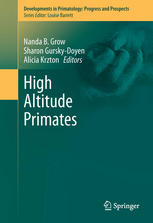

Most ebook files are in PDF format, so you can easily read them using various software such as Foxit Reader or directly on the Google Chrome browser.
Some ebook files are released by publishers in other formats such as .awz, .mobi, .epub, .fb2, etc. You may need to install specific software to read these formats on mobile/PC, such as Calibre.
Please read the tutorial at this link: https://ebookbell.com/faq
We offer FREE conversion to the popular formats you request; however, this may take some time. Therefore, right after payment, please email us, and we will try to provide the service as quickly as possible.
For some exceptional file formats or broken links (if any), please refrain from opening any disputes. Instead, email us first, and we will try to assist within a maximum of 6 hours.
EbookBell Team

4.0
76 reviewsThe basic goal of the volume is to compile the most up to date research on how high altitude affects the behavior, ecology, evolution and conservation status of primates, especially in comparison to lowland populations. Historically, the majority of primate studies have focused on lowland populations. However, as the lowlands have been disappearing, more and more primatologists have begun studying populations located in higher altitudes. High altitude populations are important not only because of their uniqueness, but also because they highlight the range of primate adaptability and the complex variables that are involved in primate evolution. These populations are good examples of how geographic scales result in diversification and/or speciation. Yet, there have been very few papers addressing how this high altitude environment affects the behavior, ecology, and conservation status of these primates.